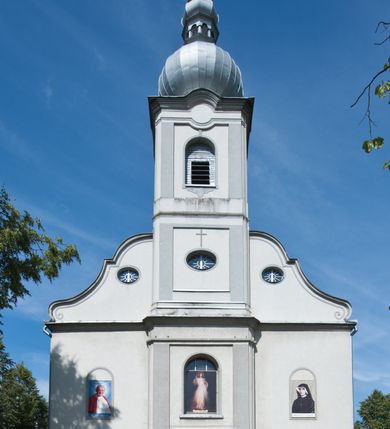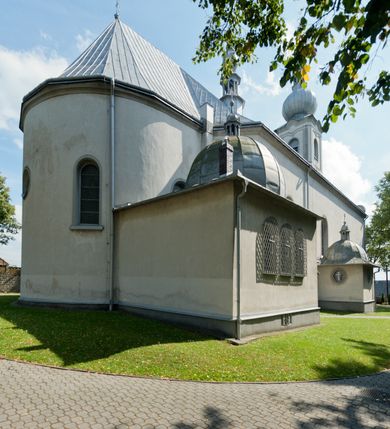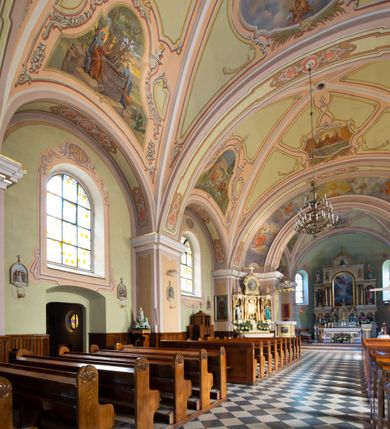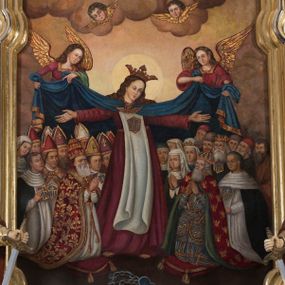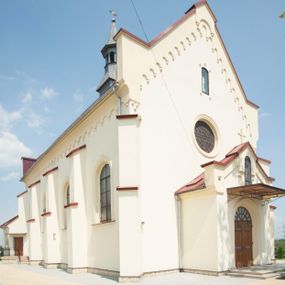
Church of the Transfiguration in Jabłonka
Identifier
DZIELO/12459
Amount
1
Catalogue note author
Maria Działo
History of work
Since 1684, Catholics in Jablonka have owned an old wooden Lutheran temple, which became a branch of the Catholic parish church in Orawka. According to the oldest records in the parish chronicle and church inventory, it was a temple dedicated to St. Mary Magdalene. It is interesting that one of its side altars was dedicated to the Transfiguration of Jesus, thus the cult of the later invocation of a new temple has been already widespread as regards the previous temple. The present brick church was built in 1802-1807 during the ministry of the parish priest Józef Janicsak 1795-1820), who was buried under the floor of the chancel. Certainly, the old furnishings were moved to the new building, from which several works have survived to this day, these are: late baroque statues of four holy virgins and a passion cross with statues of Virgin Mary, Saint John the Evangelist and Saint Mary Magdalene. According to the description of bishop Jan Władysław Pyrker's visitation of 1820, there were three altars in the church and goldsmithery reserves have not changed significantly from the time when the old church was in operation, as described in the last inventory of 1787. There were still two chalices with patents, ciborium, two pyxes for Viaticum,one pax and one monstrance. In addition, the church housed a worn-out sheet metal thurible with navicula and lamps, as well as nine wooden candle holders for altars. The number of liturgical vestments was also small. Further furnishings for the new church were bought or replaced by new ones. In 1835, pews were made, in 1877 two confessionals, in 1869 the pulpit, and in 1879, the main altar was repaired, and the side altar of the Blessed Virgin Mary underwent restoration works. Also a new baptismal font was acquired shortly. Nevertheless, the greatest transformation of the church took place at the beginning of the 20th century, when three new altars were purchased in the South Tyrolean workshop. The altars were partially renovated by local carpenters in later years. Some of the statues of the main altar (St. Cyril, St. Methods, as well as a part of the reliefs in predella) also were made by a Tyrolean workshop. In turn, statues located in side altars were brought by the parish priest Julian Łysek around 1950 and sculptures of holy women in the high altar finial were created in one of the provincial workshops. In 1914, an organ was brought to the church from Hungary and inserted into a neo-renaissance organ front. In 1937, during the works on the new vault, numerous changes were made to the body of the church by Jan and Paweł Pilarczycki - carpenters from Kiczory. The church was extended by a sacristy on the right side and two low side chapels on a square plan, covered with blank domes. The right side chapel of Madonna of Częstochowa was built in 1937 from the foundation of Eustachy Jerzy Kawiński. It is decorated with the stained glass windows from the foundation of the aforementioned Kawiński, in the Stained Glass Workshop owned by Stanisław Gabriel Żeleński from Cracow. In the years 1937-1938 also stained glass windows in the chancel were made according to the design of Kazimierz Puchała. The left side chapel of St. Maximilian Maria Kolbe was built in 1937 and it replaced the former women's gallery. Interesting stained glass windows from the foundation of father Julian Łysek can be found in the chancel of the church. They represent angels adoring the altar. Probably the church from the beginning of the 19th century was not polychromed. In the years 1937-1938, a polychrome according to the design of Kaziemierz Puchała was made in the chancel. Nevertheless the paintings were misconstrued by the parishioners and it was decided to remove them. Currently, the church is decorated with a neo-baroque polychrome from 1980-1982, which is the work of Cracovian painters: Jacek and Mieczysław Żubrowski. A solemn consecration of the church took place on 6 August 1954 (note: check why the consecration took place in 1954 - Rabiej?). Immediately before this ceremony, the side altars were transformed and renovated. It was probably then that the parish priest Julian Łysek replaced sculptures and paintings in the altars. At the turn of the 20th and 21st centuries, the interior of the church was thoroughly renovated: in 1999 the matroneum was rebuilt, in 2001 the main altar, as well as the sides altars in 2004, underwent the conservation works. In turn, in 2001, the floor in the chancel was replaced and wall paintings were refreshed (2001-2003). Nearby the church there is a stone statue of Our Lady of the Immaculate Conception from 1809, which was made by a sculpture workshop in Biały Potok.
Abstract
The Church of the Transfiguration in Jabłonka was built in 1802-1807 while Józef Janicsak was the parish priest (1795-1820), later buried under the chancel floor. Certainly, the furnishings from the old church were moved to the new building, from which several works have survived to this day, i.e. Late baroque statues of four holy virgins and a Rococo passion cross with statues of the Mother of God, Saint John the Evangelist and Saint Mary Magdalene. The main furnishings of the church are currently three altars made at the beginning of the 20th century in the workshop in South Tyrol, a pulpit from 1869 and organs brought from Hungary in 1914. While working on the new vault in 1937, numerous changes were created for the body of the church. Annexes appeared: on the right a sacristy and two low side chapels. In turn, in 1973, the left side chapel of Saint Maximilian Maria Kolbe appeared, taking the place of the former "women's gallery". The church in Jabłonka is decorated with a set of stained glass windows designed in the interwar years by Kazimierz Puchała. Particularly noteworthy are the stained glass windows in the chancel signed by the artist, depicting angels adoring the altar, the Holy Family and the Coronation of the Blessed Virgin Mary. The noteworthy monuments of goldsmiths include the monstrance from 1881, from the foundation of father Franciszek Zvad, with a six-sided, repousséd foot and radiant aureole decorated with statues of God the Father, the Holy Spirit and angels. Currently, the church is decorated with a neo-baroque polychrome from 1980-1982, which is the work of Cracovian painters: Jacek and Mieczysław Żubrowski. The church in Jabłonka is made in a style combining elements of Baroque and Classicism, called the Josephine style with a tower in the facade flanked by a pair of volutes - popular on the border between Galicia and Hungary. In the block of the church built of stone, there is a nave combined with a narrower and lower, semi-circularly closed chancel and a tower built on the nave. Nearby the church there is a stone statue of Our Lady of the Immaculate Conception from 1809, which was made by a sculpture workshop in Biały Potok.
Other works from this place
Other works from this year
Similar works
How to cite?
Maria Działo, "Church of the Transfiguration in Jabłonka", [in:] "The Sacred Lesser Poland Heritage", 2025, source: https://sdm.upjp2.edu.pl/en/works/church-of-the-transfiguration-in-jablonka


